Sociology of Culture and its Implications for Business Operations
VerifiedAdded on 2022/10/11
|14
|3909
|116
Essay
AI Summary
This essay delves into the sociology of culture, examining its impact on business activities. It explores both large and small cultural arguments, discussing the strengths and weaknesses of cultural influences in business operations. The essay begins by outlining the key elements of culture, including social organization, customs, and traditions, and then moves on to analyze how cultural symbols and values affect business practices. It differentiates between high and low cultures and their roles in shaping societal perceptions. Furthermore, it considers the implications of globalization, deregulation, and technological changes on cultural understanding. The essay also critiques organizational culture and change management, highlighting the importance of understanding and adapting to cultural differences to enhance business outcomes. It provides examples of how cultural differences impact communication and negotiation in various business contexts. The author uses a wide range of sources to support the arguments.
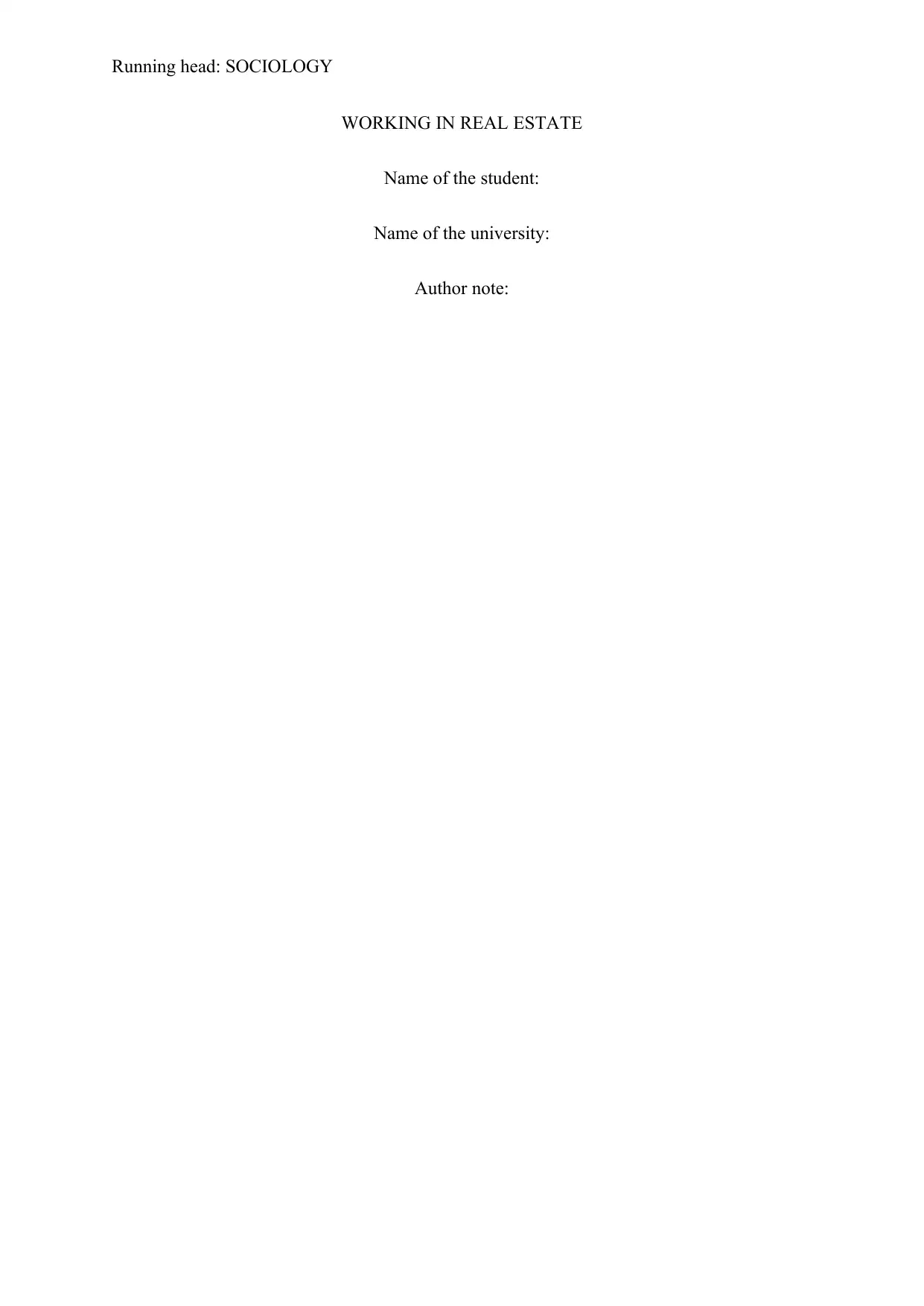
Running head: SOCIOLOGY
WORKING IN REAL ESTATE
Name of the student:
Name of the university:
Author note:
WORKING IN REAL ESTATE
Name of the student:
Name of the university:
Author note:
Paraphrase This Document
Need a fresh take? Get an instant paraphrase of this document with our AI Paraphraser
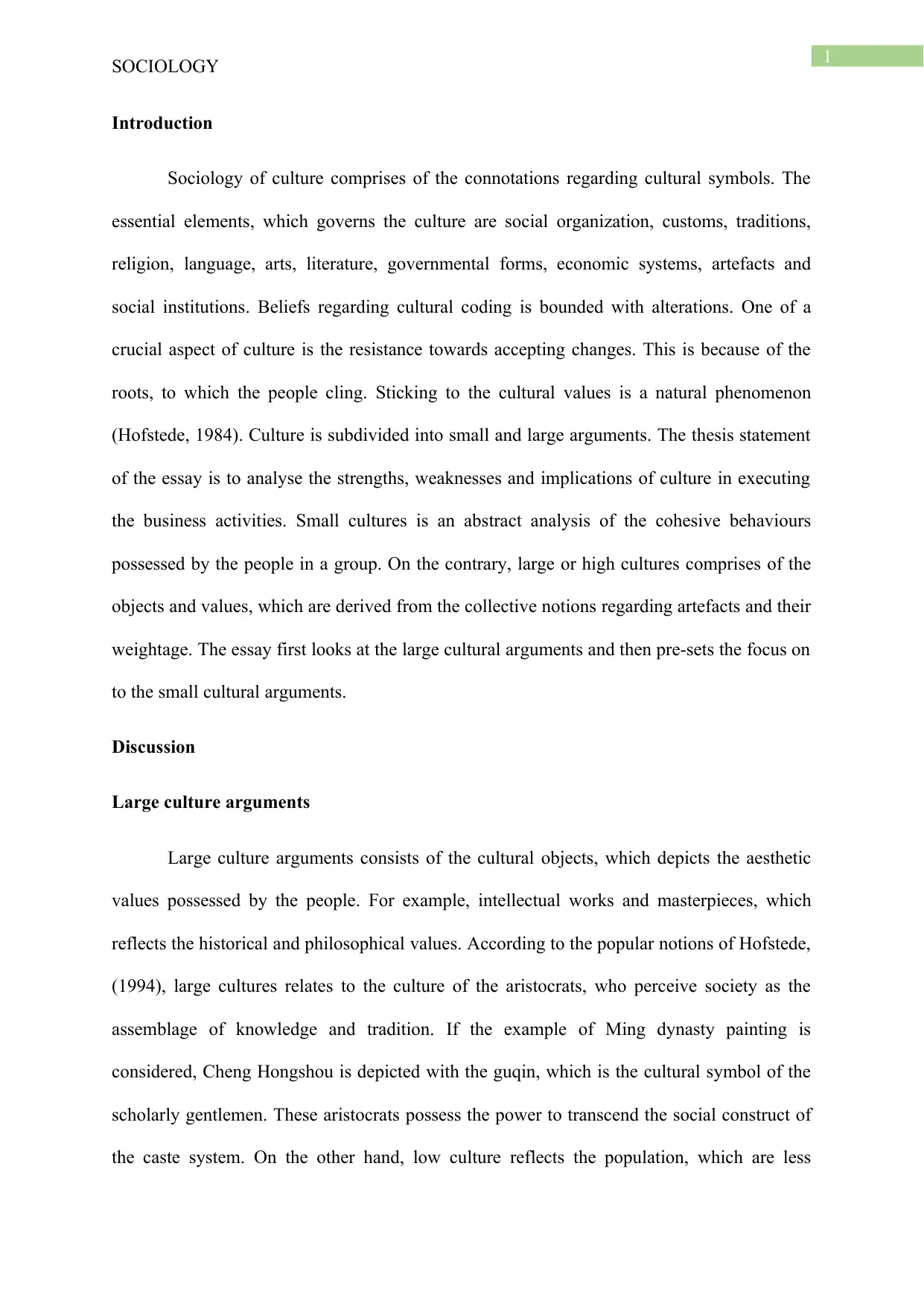
1
SOCIOLOGY
Introduction
Sociology of culture comprises of the connotations regarding cultural symbols. The
essential elements, which governs the culture are social organization, customs, traditions,
religion, language, arts, literature, governmental forms, economic systems, artefacts and
social institutions. Beliefs regarding cultural coding is bounded with alterations. One of a
crucial aspect of culture is the resistance towards accepting changes. This is because of the
roots, to which the people cling. Sticking to the cultural values is a natural phenomenon
(Hofstede, 1984). Culture is subdivided into small and large arguments. The thesis statement
of the essay is to analyse the strengths, weaknesses and implications of culture in executing
the business activities. Small cultures is an abstract analysis of the cohesive behaviours
possessed by the people in a group. On the contrary, large or high cultures comprises of the
objects and values, which are derived from the collective notions regarding artefacts and their
weightage. The essay first looks at the large cultural arguments and then pre-sets the focus on
to the small cultural arguments.
Discussion
Large culture arguments
Large culture arguments consists of the cultural objects, which depicts the aesthetic
values possessed by the people. For example, intellectual works and masterpieces, which
reflects the historical and philosophical values. According to the popular notions of Hofstede,
(1994), large cultures relates to the culture of the aristocrats, who perceive society as the
assemblage of knowledge and tradition. If the example of Ming dynasty painting is
considered, Cheng Hongshou is depicted with the guqin, which is the cultural symbol of the
scholarly gentlemen. These aristocrats possess the power to transcend the social construct of
the caste system. On the other hand, low culture reflects the population, which are less
SOCIOLOGY
Introduction
Sociology of culture comprises of the connotations regarding cultural symbols. The
essential elements, which governs the culture are social organization, customs, traditions,
religion, language, arts, literature, governmental forms, economic systems, artefacts and
social institutions. Beliefs regarding cultural coding is bounded with alterations. One of a
crucial aspect of culture is the resistance towards accepting changes. This is because of the
roots, to which the people cling. Sticking to the cultural values is a natural phenomenon
(Hofstede, 1984). Culture is subdivided into small and large arguments. The thesis statement
of the essay is to analyse the strengths, weaknesses and implications of culture in executing
the business activities. Small cultures is an abstract analysis of the cohesive behaviours
possessed by the people in a group. On the contrary, large or high cultures comprises of the
objects and values, which are derived from the collective notions regarding artefacts and their
weightage. The essay first looks at the large cultural arguments and then pre-sets the focus on
to the small cultural arguments.
Discussion
Large culture arguments
Large culture arguments consists of the cultural objects, which depicts the aesthetic
values possessed by the people. For example, intellectual works and masterpieces, which
reflects the historical and philosophical values. According to the popular notions of Hofstede,
(1994), large cultures relates to the culture of the aristocrats, who perceive society as the
assemblage of knowledge and tradition. If the example of Ming dynasty painting is
considered, Cheng Hongshou is depicted with the guqin, which is the cultural symbol of the
scholarly gentlemen. These aristocrats possess the power to transcend the social construct of
the caste system. On the other hand, low culture reflects the population, which are less
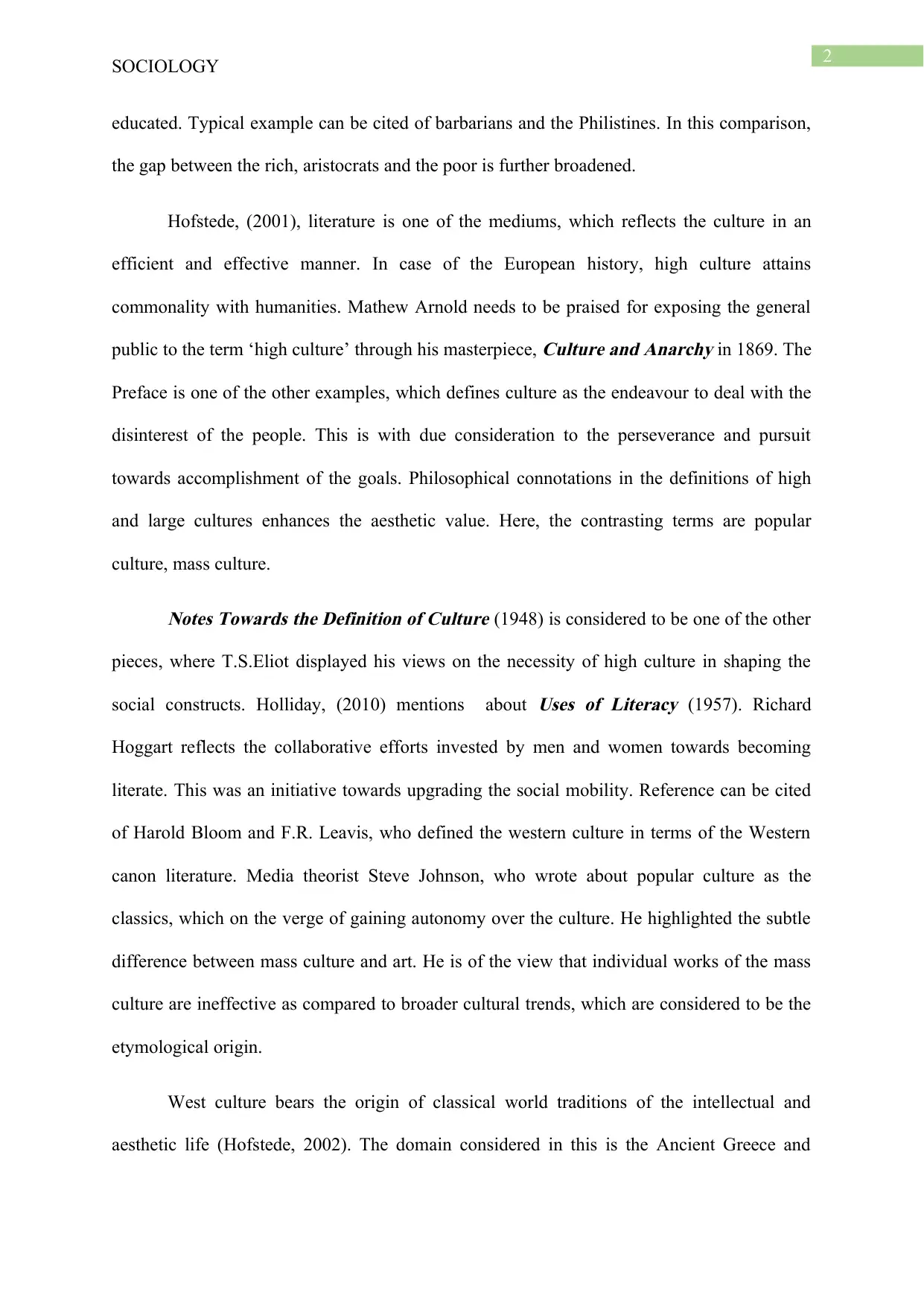
2
SOCIOLOGY
educated. Typical example can be cited of barbarians and the Philistines. In this comparison,
the gap between the rich, aristocrats and the poor is further broadened.
Hofstede, (2001), literature is one of the mediums, which reflects the culture in an
efficient and effective manner. In case of the European history, high culture attains
commonality with humanities. Mathew Arnold needs to be praised for exposing the general
public to the term ‘high culture’ through his masterpiece,
Culture and Anarchy in 1869. The
Preface is one of the other examples, which defines culture as the endeavour to deal with the
disinterest of the people. This is with due consideration to the perseverance and pursuit
towards accomplishment of the goals. Philosophical connotations in the definitions of high
and large cultures enhances the aesthetic value. Here, the contrasting terms are popular
culture, mass culture.
Notes Towards the Definition of Culture (1948) is considered to be one of the other
pieces, where T.S.Eliot displayed his views on the necessity of high culture in shaping the
social constructs. Holliday, (2010) mentions about
Uses of Literacy (1957). Richard
Hoggart reflects the collaborative efforts invested by men and women towards becoming
literate. This was an initiative towards upgrading the social mobility. Reference can be cited
of Harold Bloom and F.R. Leavis, who defined the western culture in terms of the Western
canon literature. Media theorist Steve Johnson, who wrote about popular culture as the
classics, which on the verge of gaining autonomy over the culture. He highlighted the subtle
difference between mass culture and art. He is of the view that individual works of the mass
culture are ineffective as compared to broader cultural trends, which are considered to be the
etymological origin.
West culture bears the origin of classical world traditions of the intellectual and
aesthetic life (Hofstede, 2002). The domain considered in this is the Ancient Greece and
SOCIOLOGY
educated. Typical example can be cited of barbarians and the Philistines. In this comparison,
the gap between the rich, aristocrats and the poor is further broadened.
Hofstede, (2001), literature is one of the mediums, which reflects the culture in an
efficient and effective manner. In case of the European history, high culture attains
commonality with humanities. Mathew Arnold needs to be praised for exposing the general
public to the term ‘high culture’ through his masterpiece,
Culture and Anarchy in 1869. The
Preface is one of the other examples, which defines culture as the endeavour to deal with the
disinterest of the people. This is with due consideration to the perseverance and pursuit
towards accomplishment of the goals. Philosophical connotations in the definitions of high
and large cultures enhances the aesthetic value. Here, the contrasting terms are popular
culture, mass culture.
Notes Towards the Definition of Culture (1948) is considered to be one of the other
pieces, where T.S.Eliot displayed his views on the necessity of high culture in shaping the
social constructs. Holliday, (2010) mentions about
Uses of Literacy (1957). Richard
Hoggart reflects the collaborative efforts invested by men and women towards becoming
literate. This was an initiative towards upgrading the social mobility. Reference can be cited
of Harold Bloom and F.R. Leavis, who defined the western culture in terms of the Western
canon literature. Media theorist Steve Johnson, who wrote about popular culture as the
classics, which on the verge of gaining autonomy over the culture. He highlighted the subtle
difference between mass culture and art. He is of the view that individual works of the mass
culture are ineffective as compared to broader cultural trends, which are considered to be the
etymological origin.
West culture bears the origin of classical world traditions of the intellectual and
aesthetic life (Hofstede, 2002). The domain considered in this is the Ancient Greece and
⊘ This is a preview!⊘
Do you want full access?
Subscribe today to unlock all pages.

Trusted by 1+ million students worldwide
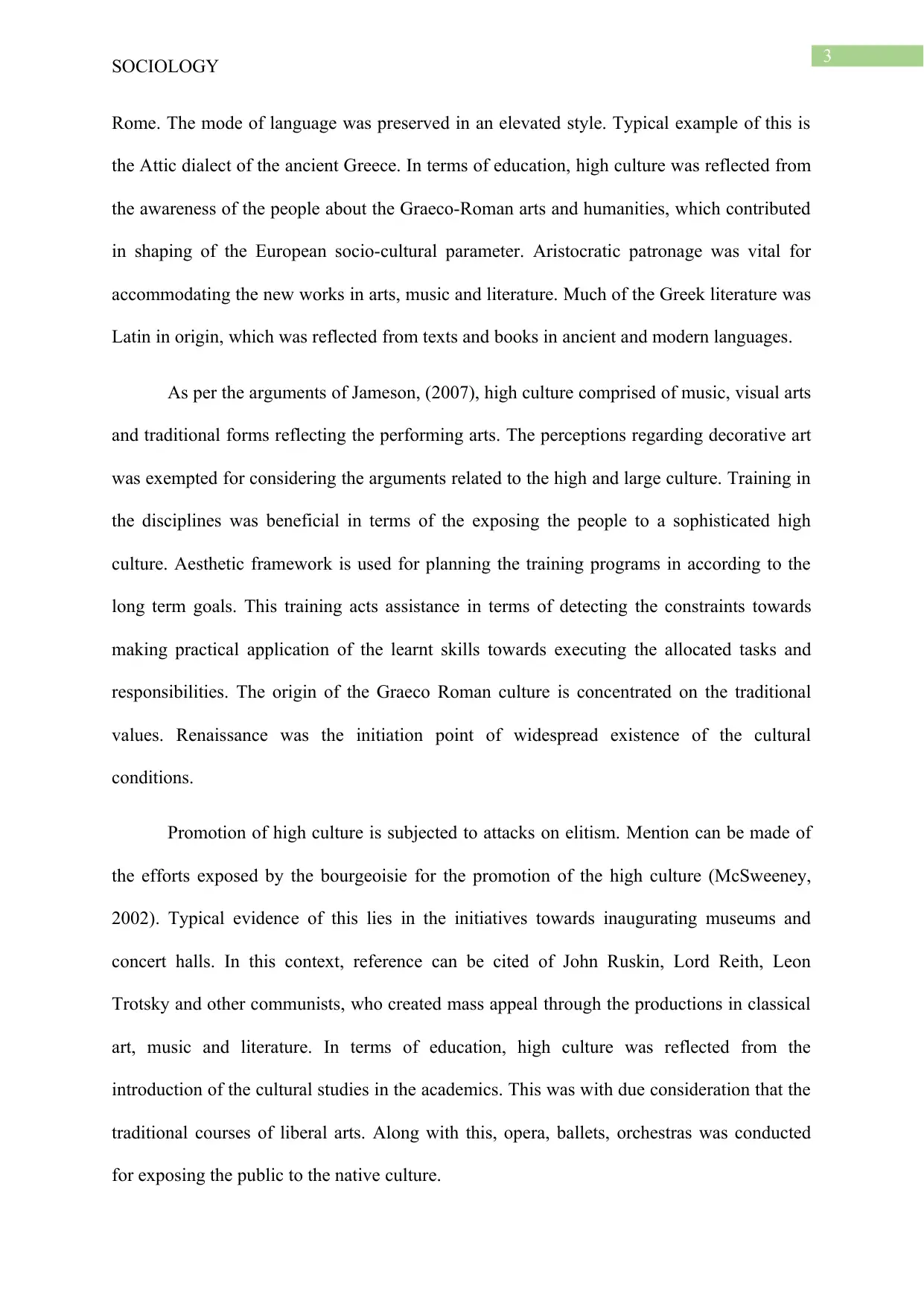
3
SOCIOLOGY
Rome. The mode of language was preserved in an elevated style. Typical example of this is
the Attic dialect of the ancient Greece. In terms of education, high culture was reflected from
the awareness of the people about the Graeco-Roman arts and humanities, which contributed
in shaping of the European socio-cultural parameter. Aristocratic patronage was vital for
accommodating the new works in arts, music and literature. Much of the Greek literature was
Latin in origin, which was reflected from texts and books in ancient and modern languages.
As per the arguments of Jameson, (2007), high culture comprised of music, visual arts
and traditional forms reflecting the performing arts. The perceptions regarding decorative art
was exempted for considering the arguments related to the high and large culture. Training in
the disciplines was beneficial in terms of the exposing the people to a sophisticated high
culture. Aesthetic framework is used for planning the training programs in according to the
long term goals. This training acts assistance in terms of detecting the constraints towards
making practical application of the learnt skills towards executing the allocated tasks and
responsibilities. The origin of the Graeco Roman culture is concentrated on the traditional
values. Renaissance was the initiation point of widespread existence of the cultural
conditions.
Promotion of high culture is subjected to attacks on elitism. Mention can be made of
the efforts exposed by the bourgeoisie for the promotion of the high culture (McSweeney,
2002). Typical evidence of this lies in the initiatives towards inaugurating museums and
concert halls. In this context, reference can be cited of John Ruskin, Lord Reith, Leon
Trotsky and other communists, who created mass appeal through the productions in classical
art, music and literature. In terms of education, high culture was reflected from the
introduction of the cultural studies in the academics. This was with due consideration that the
traditional courses of liberal arts. Along with this, opera, ballets, orchestras was conducted
for exposing the public to the native culture.
SOCIOLOGY
Rome. The mode of language was preserved in an elevated style. Typical example of this is
the Attic dialect of the ancient Greece. In terms of education, high culture was reflected from
the awareness of the people about the Graeco-Roman arts and humanities, which contributed
in shaping of the European socio-cultural parameter. Aristocratic patronage was vital for
accommodating the new works in arts, music and literature. Much of the Greek literature was
Latin in origin, which was reflected from texts and books in ancient and modern languages.
As per the arguments of Jameson, (2007), high culture comprised of music, visual arts
and traditional forms reflecting the performing arts. The perceptions regarding decorative art
was exempted for considering the arguments related to the high and large culture. Training in
the disciplines was beneficial in terms of the exposing the people to a sophisticated high
culture. Aesthetic framework is used for planning the training programs in according to the
long term goals. This training acts assistance in terms of detecting the constraints towards
making practical application of the learnt skills towards executing the allocated tasks and
responsibilities. The origin of the Graeco Roman culture is concentrated on the traditional
values. Renaissance was the initiation point of widespread existence of the cultural
conditions.
Promotion of high culture is subjected to attacks on elitism. Mention can be made of
the efforts exposed by the bourgeoisie for the promotion of the high culture (McSweeney,
2002). Typical evidence of this lies in the initiatives towards inaugurating museums and
concert halls. In this context, reference can be cited of John Ruskin, Lord Reith, Leon
Trotsky and other communists, who created mass appeal through the productions in classical
art, music and literature. In terms of education, high culture was reflected from the
introduction of the cultural studies in the academics. This was with due consideration that the
traditional courses of liberal arts. Along with this, opera, ballets, orchestras was conducted
for exposing the public to the native culture.
Paraphrase This Document
Need a fresh take? Get an instant paraphrase of this document with our AI Paraphraser
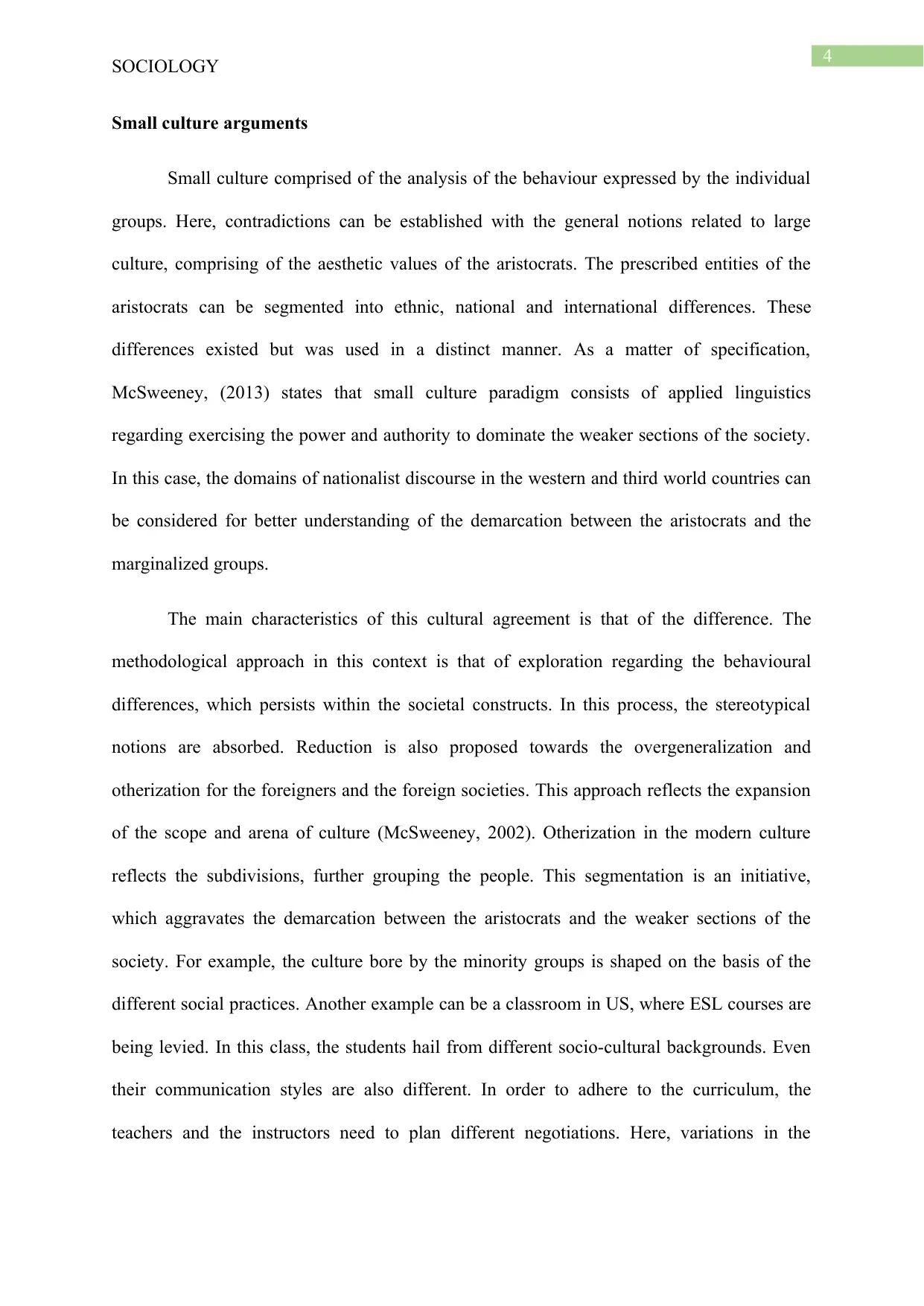
4
SOCIOLOGY
Small culture arguments
Small culture comprised of the analysis of the behaviour expressed by the individual
groups. Here, contradictions can be established with the general notions related to large
culture, comprising of the aesthetic values of the aristocrats. The prescribed entities of the
aristocrats can be segmented into ethnic, national and international differences. These
differences existed but was used in a distinct manner. As a matter of specification,
McSweeney, (2013) states that small culture paradigm consists of applied linguistics
regarding exercising the power and authority to dominate the weaker sections of the society.
In this case, the domains of nationalist discourse in the western and third world countries can
be considered for better understanding of the demarcation between the aristocrats and the
marginalized groups.
The main characteristics of this cultural agreement is that of the difference. The
methodological approach in this context is that of exploration regarding the behavioural
differences, which persists within the societal constructs. In this process, the stereotypical
notions are absorbed. Reduction is also proposed towards the overgeneralization and
otherization for the foreigners and the foreign societies. This approach reflects the expansion
of the scope and arena of culture (McSweeney, 2002). Otherization in the modern culture
reflects the subdivisions, further grouping the people. This segmentation is an initiative,
which aggravates the demarcation between the aristocrats and the weaker sections of the
society. For example, the culture bore by the minority groups is shaped on the basis of the
different social practices. Another example can be a classroom in US, where ESL courses are
being levied. In this class, the students hail from different socio-cultural backgrounds. Even
their communication styles are also different. In order to adhere to the curriculum, the
teachers and the instructors need to plan different negotiations. Here, variations in the
SOCIOLOGY
Small culture arguments
Small culture comprised of the analysis of the behaviour expressed by the individual
groups. Here, contradictions can be established with the general notions related to large
culture, comprising of the aesthetic values of the aristocrats. The prescribed entities of the
aristocrats can be segmented into ethnic, national and international differences. These
differences existed but was used in a distinct manner. As a matter of specification,
McSweeney, (2013) states that small culture paradigm consists of applied linguistics
regarding exercising the power and authority to dominate the weaker sections of the society.
In this case, the domains of nationalist discourse in the western and third world countries can
be considered for better understanding of the demarcation between the aristocrats and the
marginalized groups.
The main characteristics of this cultural agreement is that of the difference. The
methodological approach in this context is that of exploration regarding the behavioural
differences, which persists within the societal constructs. In this process, the stereotypical
notions are absorbed. Reduction is also proposed towards the overgeneralization and
otherization for the foreigners and the foreign societies. This approach reflects the expansion
of the scope and arena of culture (McSweeney, 2002). Otherization in the modern culture
reflects the subdivisions, further grouping the people. This segmentation is an initiative,
which aggravates the demarcation between the aristocrats and the weaker sections of the
society. For example, the culture bore by the minority groups is shaped on the basis of the
different social practices. Another example can be a classroom in US, where ESL courses are
being levied. In this class, the students hail from different socio-cultural backgrounds. Even
their communication styles are also different. In order to adhere to the curriculum, the
teachers and the instructors need to plan different negotiations. Here, variations in the
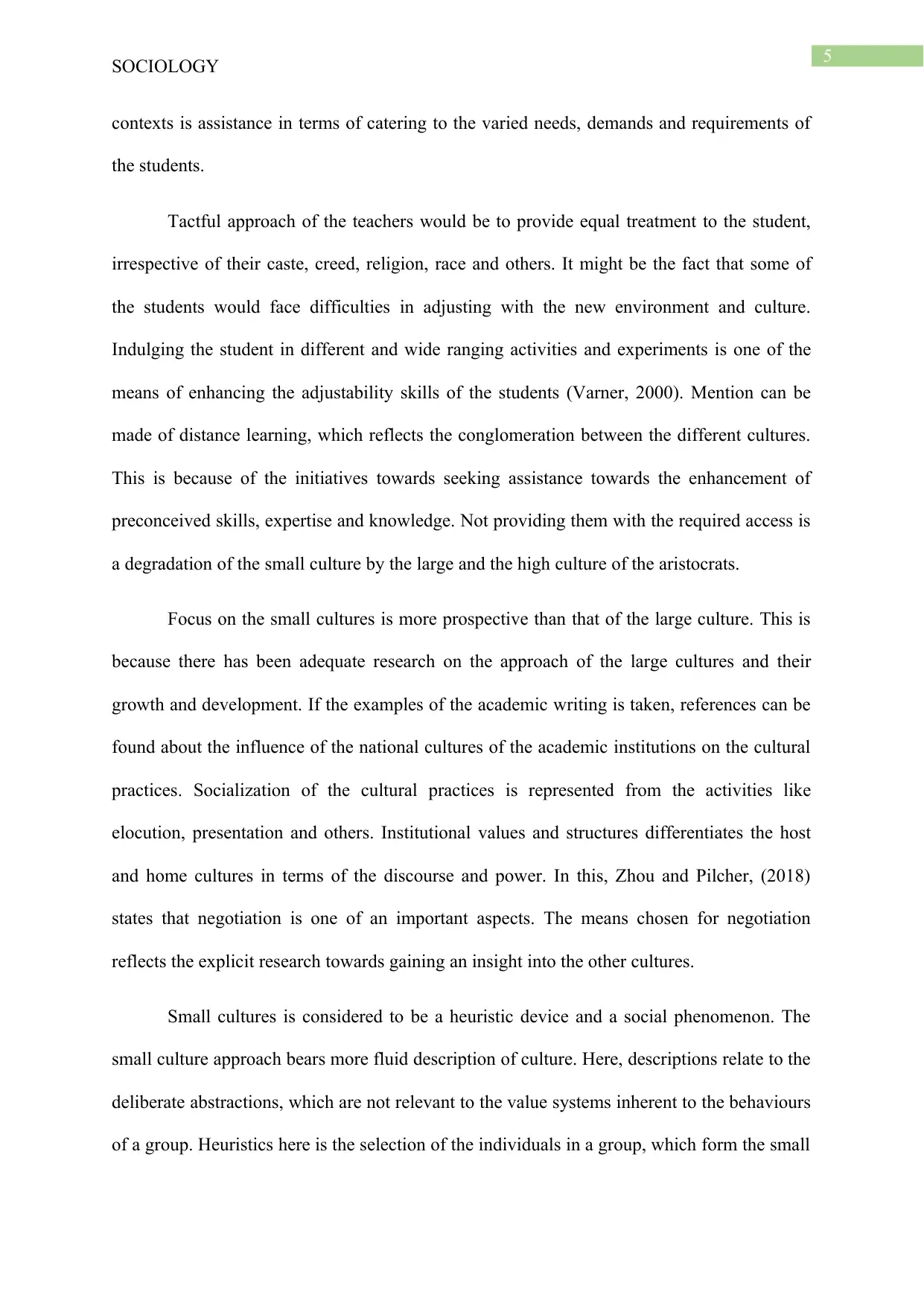
5
SOCIOLOGY
contexts is assistance in terms of catering to the varied needs, demands and requirements of
the students.
Tactful approach of the teachers would be to provide equal treatment to the student,
irrespective of their caste, creed, religion, race and others. It might be the fact that some of
the students would face difficulties in adjusting with the new environment and culture.
Indulging the student in different and wide ranging activities and experiments is one of the
means of enhancing the adjustability skills of the students (Varner, 2000). Mention can be
made of distance learning, which reflects the conglomeration between the different cultures.
This is because of the initiatives towards seeking assistance towards the enhancement of
preconceived skills, expertise and knowledge. Not providing them with the required access is
a degradation of the small culture by the large and the high culture of the aristocrats.
Focus on the small cultures is more prospective than that of the large culture. This is
because there has been adequate research on the approach of the large cultures and their
growth and development. If the examples of the academic writing is taken, references can be
found about the influence of the national cultures of the academic institutions on the cultural
practices. Socialization of the cultural practices is represented from the activities like
elocution, presentation and others. Institutional values and structures differentiates the host
and home cultures in terms of the discourse and power. In this, Zhou and Pilcher, (2018)
states that negotiation is one of an important aspects. The means chosen for negotiation
reflects the explicit research towards gaining an insight into the other cultures.
Small cultures is considered to be a heuristic device and a social phenomenon. The
small culture approach bears more fluid description of culture. Here, descriptions relate to the
deliberate abstractions, which are not relevant to the value systems inherent to the behaviours
of a group. Heuristics here is the selection of the individuals in a group, which form the small
SOCIOLOGY
contexts is assistance in terms of catering to the varied needs, demands and requirements of
the students.
Tactful approach of the teachers would be to provide equal treatment to the student,
irrespective of their caste, creed, religion, race and others. It might be the fact that some of
the students would face difficulties in adjusting with the new environment and culture.
Indulging the student in different and wide ranging activities and experiments is one of the
means of enhancing the adjustability skills of the students (Varner, 2000). Mention can be
made of distance learning, which reflects the conglomeration between the different cultures.
This is because of the initiatives towards seeking assistance towards the enhancement of
preconceived skills, expertise and knowledge. Not providing them with the required access is
a degradation of the small culture by the large and the high culture of the aristocrats.
Focus on the small cultures is more prospective than that of the large culture. This is
because there has been adequate research on the approach of the large cultures and their
growth and development. If the examples of the academic writing is taken, references can be
found about the influence of the national cultures of the academic institutions on the cultural
practices. Socialization of the cultural practices is represented from the activities like
elocution, presentation and others. Institutional values and structures differentiates the host
and home cultures in terms of the discourse and power. In this, Zhou and Pilcher, (2018)
states that negotiation is one of an important aspects. The means chosen for negotiation
reflects the explicit research towards gaining an insight into the other cultures.
Small cultures is considered to be a heuristic device and a social phenomenon. The
small culture approach bears more fluid description of culture. Here, descriptions relate to the
deliberate abstractions, which are not relevant to the value systems inherent to the behaviours
of a group. Heuristics here is the selection of the individuals in a group, which form the small
⊘ This is a preview!⊘
Do you want full access?
Subscribe today to unlock all pages.

Trusted by 1+ million students worldwide
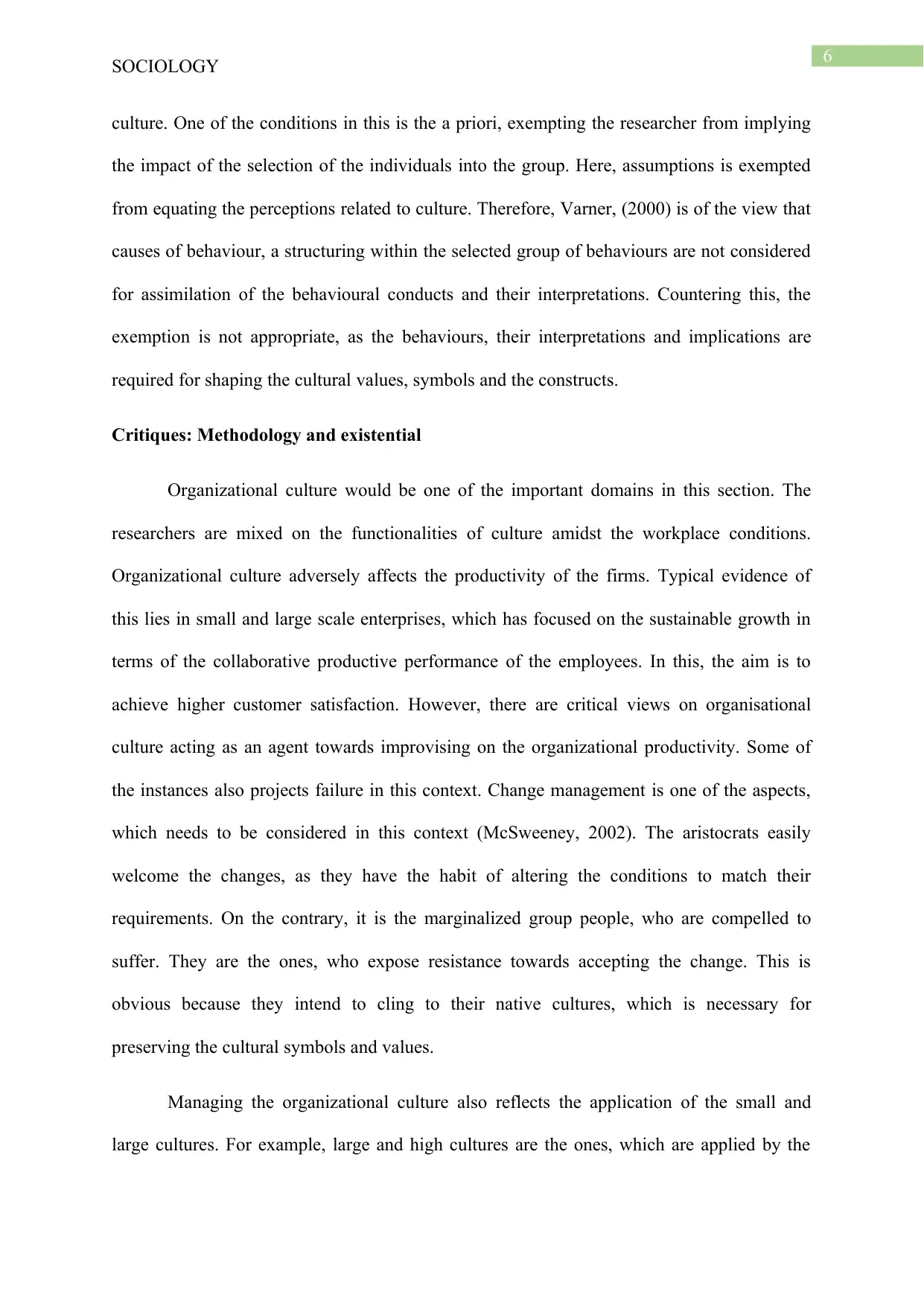
6
SOCIOLOGY
culture. One of the conditions in this is the a priori, exempting the researcher from implying
the impact of the selection of the individuals into the group. Here, assumptions is exempted
from equating the perceptions related to culture. Therefore, Varner, (2000) is of the view that
causes of behaviour, a structuring within the selected group of behaviours are not considered
for assimilation of the behavioural conducts and their interpretations. Countering this, the
exemption is not appropriate, as the behaviours, their interpretations and implications are
required for shaping the cultural values, symbols and the constructs.
Critiques: Methodology and existential
Organizational culture would be one of the important domains in this section. The
researchers are mixed on the functionalities of culture amidst the workplace conditions.
Organizational culture adversely affects the productivity of the firms. Typical evidence of
this lies in small and large scale enterprises, which has focused on the sustainable growth in
terms of the collaborative productive performance of the employees. In this, the aim is to
achieve higher customer satisfaction. However, there are critical views on organisational
culture acting as an agent towards improvising on the organizational productivity. Some of
the instances also projects failure in this context. Change management is one of the aspects,
which needs to be considered in this context (McSweeney, 2002). The aristocrats easily
welcome the changes, as they have the habit of altering the conditions to match their
requirements. On the contrary, it is the marginalized group people, who are compelled to
suffer. They are the ones, who expose resistance towards accepting the change. This is
obvious because they intend to cling to their native cultures, which is necessary for
preserving the cultural symbols and values.
Managing the organizational culture also reflects the application of the small and
large cultures. For example, large and high cultures are the ones, which are applied by the
SOCIOLOGY
culture. One of the conditions in this is the a priori, exempting the researcher from implying
the impact of the selection of the individuals into the group. Here, assumptions is exempted
from equating the perceptions related to culture. Therefore, Varner, (2000) is of the view that
causes of behaviour, a structuring within the selected group of behaviours are not considered
for assimilation of the behavioural conducts and their interpretations. Countering this, the
exemption is not appropriate, as the behaviours, their interpretations and implications are
required for shaping the cultural values, symbols and the constructs.
Critiques: Methodology and existential
Organizational culture would be one of the important domains in this section. The
researchers are mixed on the functionalities of culture amidst the workplace conditions.
Organizational culture adversely affects the productivity of the firms. Typical evidence of
this lies in small and large scale enterprises, which has focused on the sustainable growth in
terms of the collaborative productive performance of the employees. In this, the aim is to
achieve higher customer satisfaction. However, there are critical views on organisational
culture acting as an agent towards improvising on the organizational productivity. Some of
the instances also projects failure in this context. Change management is one of the aspects,
which needs to be considered in this context (McSweeney, 2002). The aristocrats easily
welcome the changes, as they have the habit of altering the conditions to match their
requirements. On the contrary, it is the marginalized group people, who are compelled to
suffer. They are the ones, who expose resistance towards accepting the change. This is
obvious because they intend to cling to their native cultures, which is necessary for
preserving the cultural symbols and values.
Managing the organizational culture also reflects the application of the small and
large cultures. For example, large and high cultures are the ones, which are applied by the
Paraphrase This Document
Need a fresh take? Get an instant paraphrase of this document with our AI Paraphraser
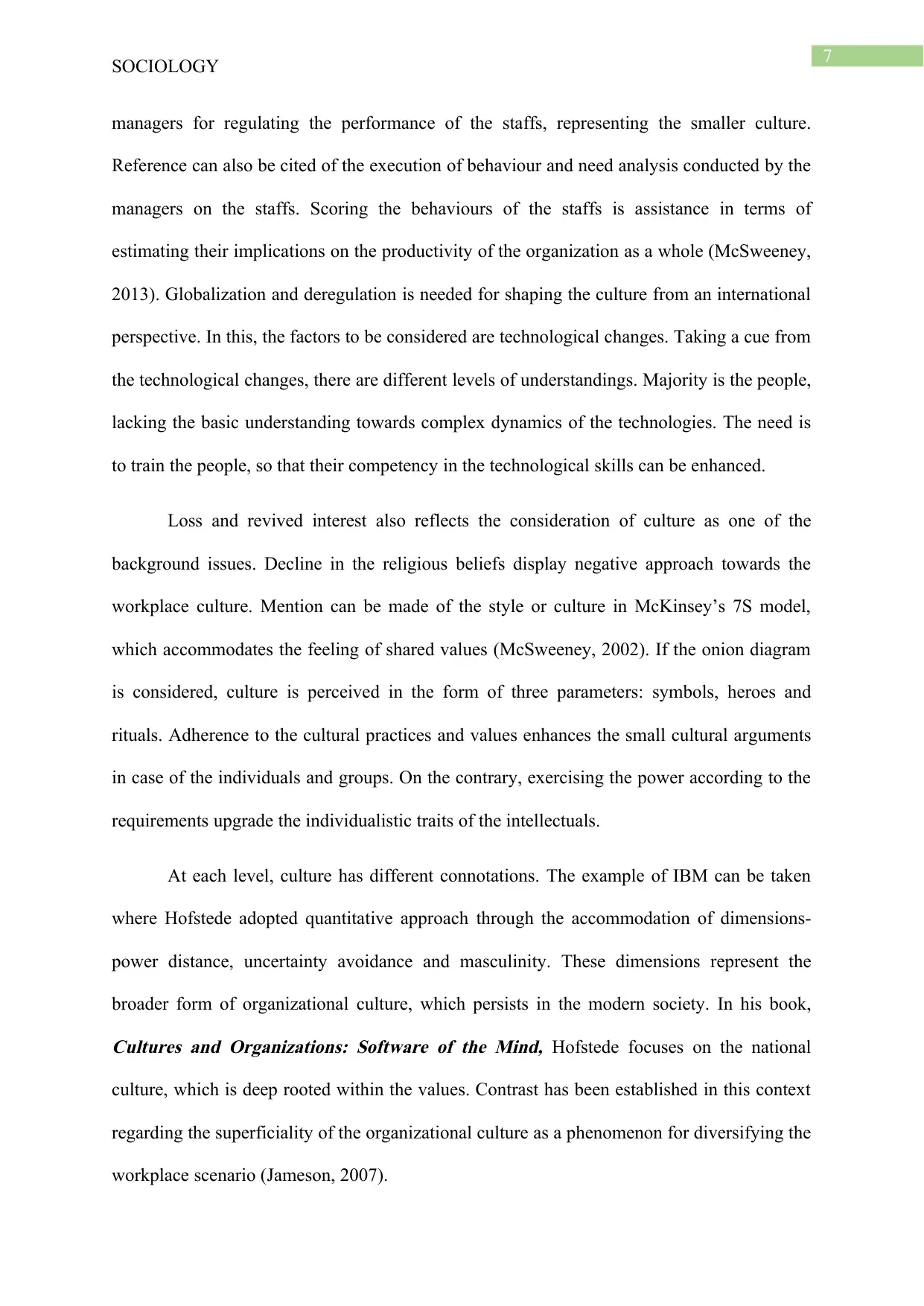
7
SOCIOLOGY
managers for regulating the performance of the staffs, representing the smaller culture.
Reference can also be cited of the execution of behaviour and need analysis conducted by the
managers on the staffs. Scoring the behaviours of the staffs is assistance in terms of
estimating their implications on the productivity of the organization as a whole (McSweeney,
2013). Globalization and deregulation is needed for shaping the culture from an international
perspective. In this, the factors to be considered are technological changes. Taking a cue from
the technological changes, there are different levels of understandings. Majority is the people,
lacking the basic understanding towards complex dynamics of the technologies. The need is
to train the people, so that their competency in the technological skills can be enhanced.
Loss and revived interest also reflects the consideration of culture as one of the
background issues. Decline in the religious beliefs display negative approach towards the
workplace culture. Mention can be made of the style or culture in McKinsey’s 7S model,
which accommodates the feeling of shared values (McSweeney, 2002). If the onion diagram
is considered, culture is perceived in the form of three parameters: symbols, heroes and
rituals. Adherence to the cultural practices and values enhances the small cultural arguments
in case of the individuals and groups. On the contrary, exercising the power according to the
requirements upgrade the individualistic traits of the intellectuals.
At each level, culture has different connotations. The example of IBM can be taken
where Hofstede adopted quantitative approach through the accommodation of dimensions-
power distance, uncertainty avoidance and masculinity. These dimensions represent the
broader form of organizational culture, which persists in the modern society. In his book,
Cultures and Organizations: Software of the Mind, Hofstede focuses on the national
culture, which is deep rooted within the values. Contrast has been established in this context
regarding the superficiality of the organizational culture as a phenomenon for diversifying the
workplace scenario (Jameson, 2007).
SOCIOLOGY
managers for regulating the performance of the staffs, representing the smaller culture.
Reference can also be cited of the execution of behaviour and need analysis conducted by the
managers on the staffs. Scoring the behaviours of the staffs is assistance in terms of
estimating their implications on the productivity of the organization as a whole (McSweeney,
2013). Globalization and deregulation is needed for shaping the culture from an international
perspective. In this, the factors to be considered are technological changes. Taking a cue from
the technological changes, there are different levels of understandings. Majority is the people,
lacking the basic understanding towards complex dynamics of the technologies. The need is
to train the people, so that their competency in the technological skills can be enhanced.
Loss and revived interest also reflects the consideration of culture as one of the
background issues. Decline in the religious beliefs display negative approach towards the
workplace culture. Mention can be made of the style or culture in McKinsey’s 7S model,
which accommodates the feeling of shared values (McSweeney, 2002). If the onion diagram
is considered, culture is perceived in the form of three parameters: symbols, heroes and
rituals. Adherence to the cultural practices and values enhances the small cultural arguments
in case of the individuals and groups. On the contrary, exercising the power according to the
requirements upgrade the individualistic traits of the intellectuals.
At each level, culture has different connotations. The example of IBM can be taken
where Hofstede adopted quantitative approach through the accommodation of dimensions-
power distance, uncertainty avoidance and masculinity. These dimensions represent the
broader form of organizational culture, which persists in the modern society. In his book,
Cultures and Organizations: Software of the Mind, Hofstede focuses on the national
culture, which is deep rooted within the values. Contrast has been established in this context
regarding the superficiality of the organizational culture as a phenomenon for diversifying the
workplace scenario (Jameson, 2007).
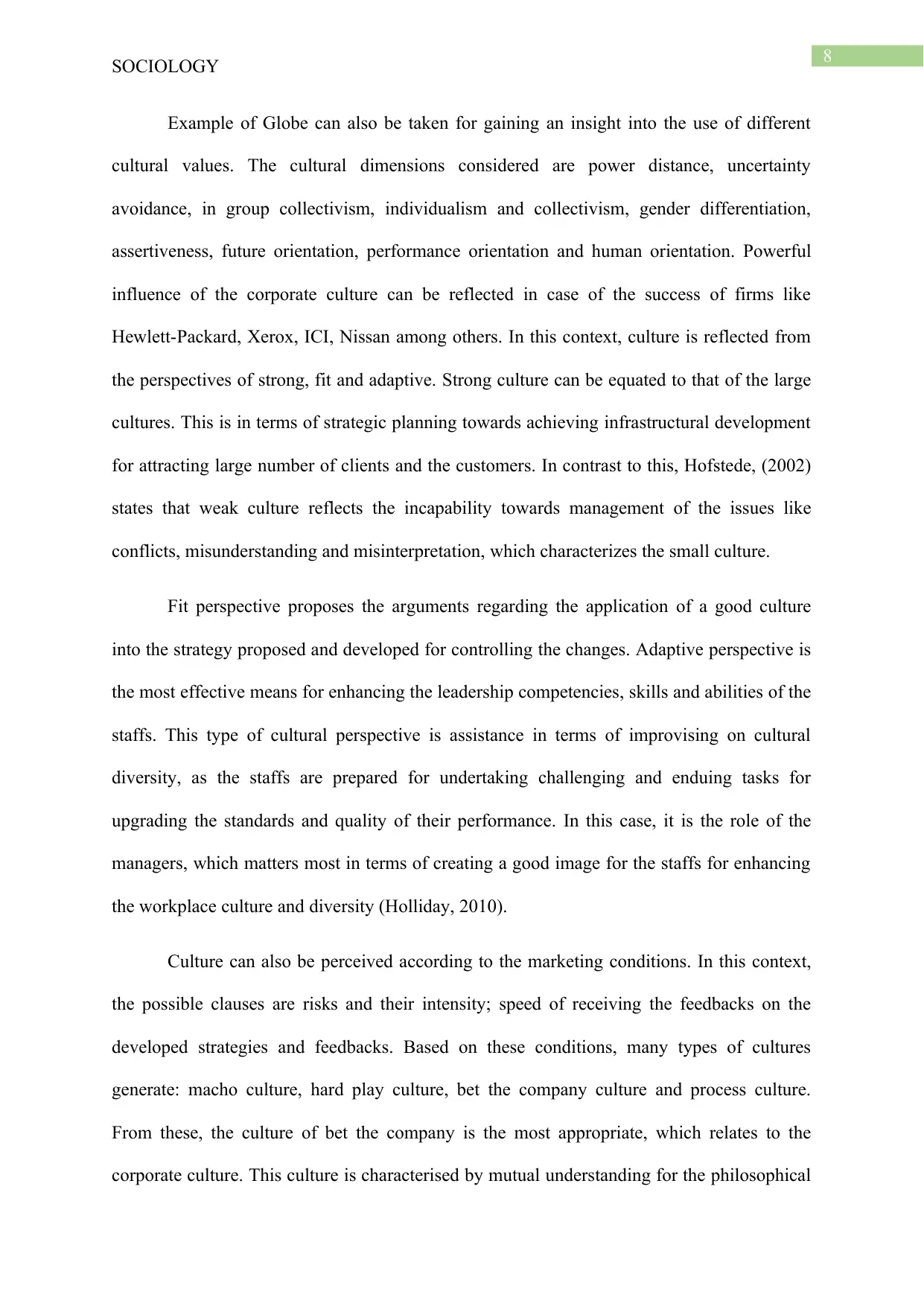
8
SOCIOLOGY
Example of Globe can also be taken for gaining an insight into the use of different
cultural values. The cultural dimensions considered are power distance, uncertainty
avoidance, in group collectivism, individualism and collectivism, gender differentiation,
assertiveness, future orientation, performance orientation and human orientation. Powerful
influence of the corporate culture can be reflected in case of the success of firms like
Hewlett-Packard, Xerox, ICI, Nissan among others. In this context, culture is reflected from
the perspectives of strong, fit and adaptive. Strong culture can be equated to that of the large
cultures. This is in terms of strategic planning towards achieving infrastructural development
for attracting large number of clients and the customers. In contrast to this, Hofstede, (2002)
states that weak culture reflects the incapability towards management of the issues like
conflicts, misunderstanding and misinterpretation, which characterizes the small culture.
Fit perspective proposes the arguments regarding the application of a good culture
into the strategy proposed and developed for controlling the changes. Adaptive perspective is
the most effective means for enhancing the leadership competencies, skills and abilities of the
staffs. This type of cultural perspective is assistance in terms of improvising on cultural
diversity, as the staffs are prepared for undertaking challenging and enduing tasks for
upgrading the standards and quality of their performance. In this case, it is the role of the
managers, which matters most in terms of creating a good image for the staffs for enhancing
the workplace culture and diversity (Holliday, 2010).
Culture can also be perceived according to the marketing conditions. In this context,
the possible clauses are risks and their intensity; speed of receiving the feedbacks on the
developed strategies and feedbacks. Based on these conditions, many types of cultures
generate: macho culture, hard play culture, bet the company culture and process culture.
From these, the culture of bet the company is the most appropriate, which relates to the
corporate culture. This culture is characterised by mutual understanding for the philosophical
SOCIOLOGY
Example of Globe can also be taken for gaining an insight into the use of different
cultural values. The cultural dimensions considered are power distance, uncertainty
avoidance, in group collectivism, individualism and collectivism, gender differentiation,
assertiveness, future orientation, performance orientation and human orientation. Powerful
influence of the corporate culture can be reflected in case of the success of firms like
Hewlett-Packard, Xerox, ICI, Nissan among others. In this context, culture is reflected from
the perspectives of strong, fit and adaptive. Strong culture can be equated to that of the large
cultures. This is in terms of strategic planning towards achieving infrastructural development
for attracting large number of clients and the customers. In contrast to this, Hofstede, (2002)
states that weak culture reflects the incapability towards management of the issues like
conflicts, misunderstanding and misinterpretation, which characterizes the small culture.
Fit perspective proposes the arguments regarding the application of a good culture
into the strategy proposed and developed for controlling the changes. Adaptive perspective is
the most effective means for enhancing the leadership competencies, skills and abilities of the
staffs. This type of cultural perspective is assistance in terms of improvising on cultural
diversity, as the staffs are prepared for undertaking challenging and enduing tasks for
upgrading the standards and quality of their performance. In this case, it is the role of the
managers, which matters most in terms of creating a good image for the staffs for enhancing
the workplace culture and diversity (Holliday, 2010).
Culture can also be perceived according to the marketing conditions. In this context,
the possible clauses are risks and their intensity; speed of receiving the feedbacks on the
developed strategies and feedbacks. Based on these conditions, many types of cultures
generate: macho culture, hard play culture, bet the company culture and process culture.
From these, the culture of bet the company is the most appropriate, which relates to the
corporate culture. This culture is characterised by mutual understanding for the philosophical
⊘ This is a preview!⊘
Do you want full access?
Subscribe today to unlock all pages.

Trusted by 1+ million students worldwide
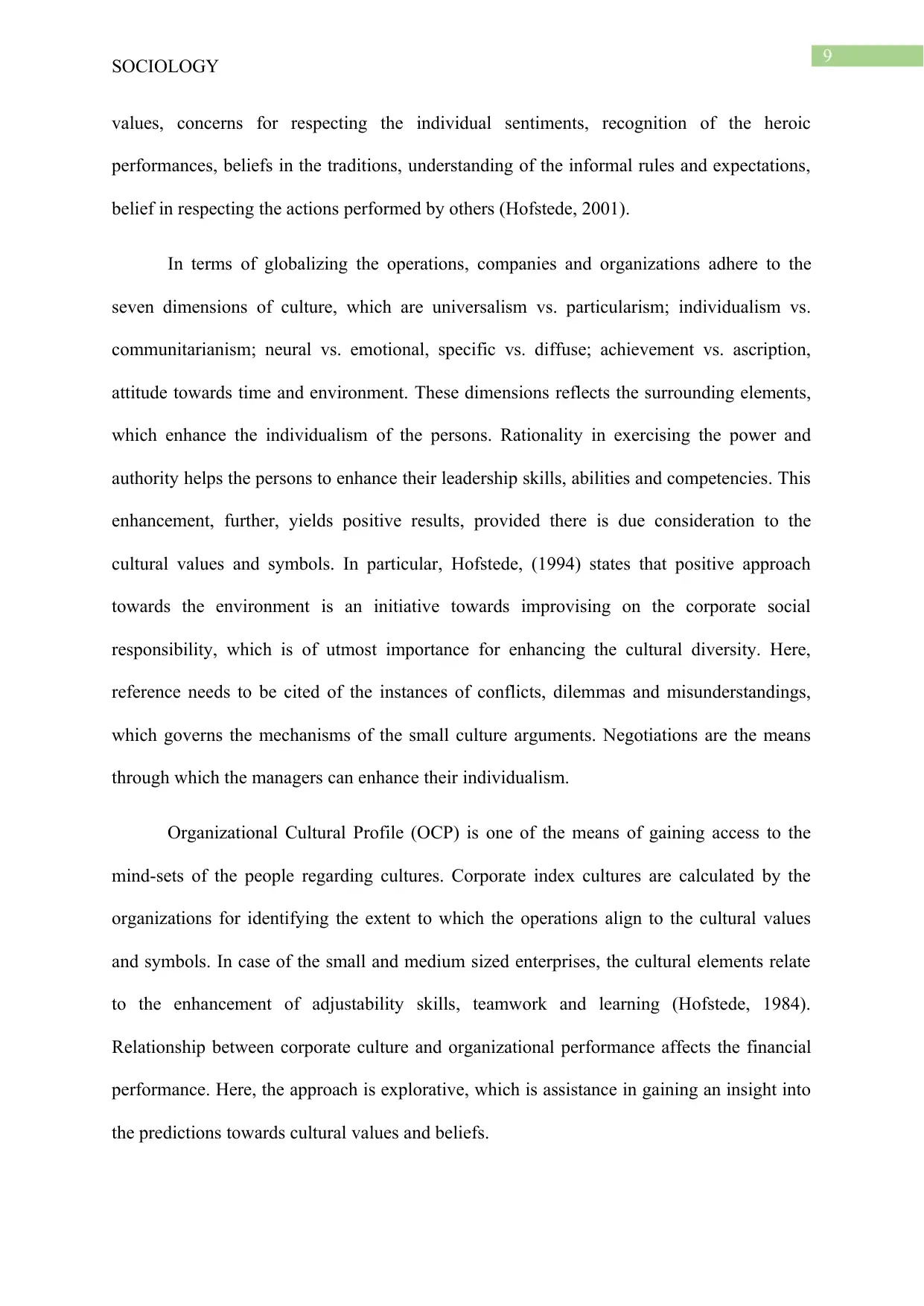
9
SOCIOLOGY
values, concerns for respecting the individual sentiments, recognition of the heroic
performances, beliefs in the traditions, understanding of the informal rules and expectations,
belief in respecting the actions performed by others (Hofstede, 2001).
In terms of globalizing the operations, companies and organizations adhere to the
seven dimensions of culture, which are universalism vs. particularism; individualism vs.
communitarianism; neural vs. emotional, specific vs. diffuse; achievement vs. ascription,
attitude towards time and environment. These dimensions reflects the surrounding elements,
which enhance the individualism of the persons. Rationality in exercising the power and
authority helps the persons to enhance their leadership skills, abilities and competencies. This
enhancement, further, yields positive results, provided there is due consideration to the
cultural values and symbols. In particular, Hofstede, (1994) states that positive approach
towards the environment is an initiative towards improvising on the corporate social
responsibility, which is of utmost importance for enhancing the cultural diversity. Here,
reference needs to be cited of the instances of conflicts, dilemmas and misunderstandings,
which governs the mechanisms of the small culture arguments. Negotiations are the means
through which the managers can enhance their individualism.
Organizational Cultural Profile (OCP) is one of the means of gaining access to the
mind-sets of the people regarding cultures. Corporate index cultures are calculated by the
organizations for identifying the extent to which the operations align to the cultural values
and symbols. In case of the small and medium sized enterprises, the cultural elements relate
to the enhancement of adjustability skills, teamwork and learning (Hofstede, 1984).
Relationship between corporate culture and organizational performance affects the financial
performance. Here, the approach is explorative, which is assistance in gaining an insight into
the predictions towards cultural values and beliefs.
SOCIOLOGY
values, concerns for respecting the individual sentiments, recognition of the heroic
performances, beliefs in the traditions, understanding of the informal rules and expectations,
belief in respecting the actions performed by others (Hofstede, 2001).
In terms of globalizing the operations, companies and organizations adhere to the
seven dimensions of culture, which are universalism vs. particularism; individualism vs.
communitarianism; neural vs. emotional, specific vs. diffuse; achievement vs. ascription,
attitude towards time and environment. These dimensions reflects the surrounding elements,
which enhance the individualism of the persons. Rationality in exercising the power and
authority helps the persons to enhance their leadership skills, abilities and competencies. This
enhancement, further, yields positive results, provided there is due consideration to the
cultural values and symbols. In particular, Hofstede, (1994) states that positive approach
towards the environment is an initiative towards improvising on the corporate social
responsibility, which is of utmost importance for enhancing the cultural diversity. Here,
reference needs to be cited of the instances of conflicts, dilemmas and misunderstandings,
which governs the mechanisms of the small culture arguments. Negotiations are the means
through which the managers can enhance their individualism.
Organizational Cultural Profile (OCP) is one of the means of gaining access to the
mind-sets of the people regarding cultures. Corporate index cultures are calculated by the
organizations for identifying the extent to which the operations align to the cultural values
and symbols. In case of the small and medium sized enterprises, the cultural elements relate
to the enhancement of adjustability skills, teamwork and learning (Hofstede, 1984).
Relationship between corporate culture and organizational performance affects the financial
performance. Here, the approach is explorative, which is assistance in gaining an insight into
the predictions towards cultural values and beliefs.
Paraphrase This Document
Need a fresh take? Get an instant paraphrase of this document with our AI Paraphraser
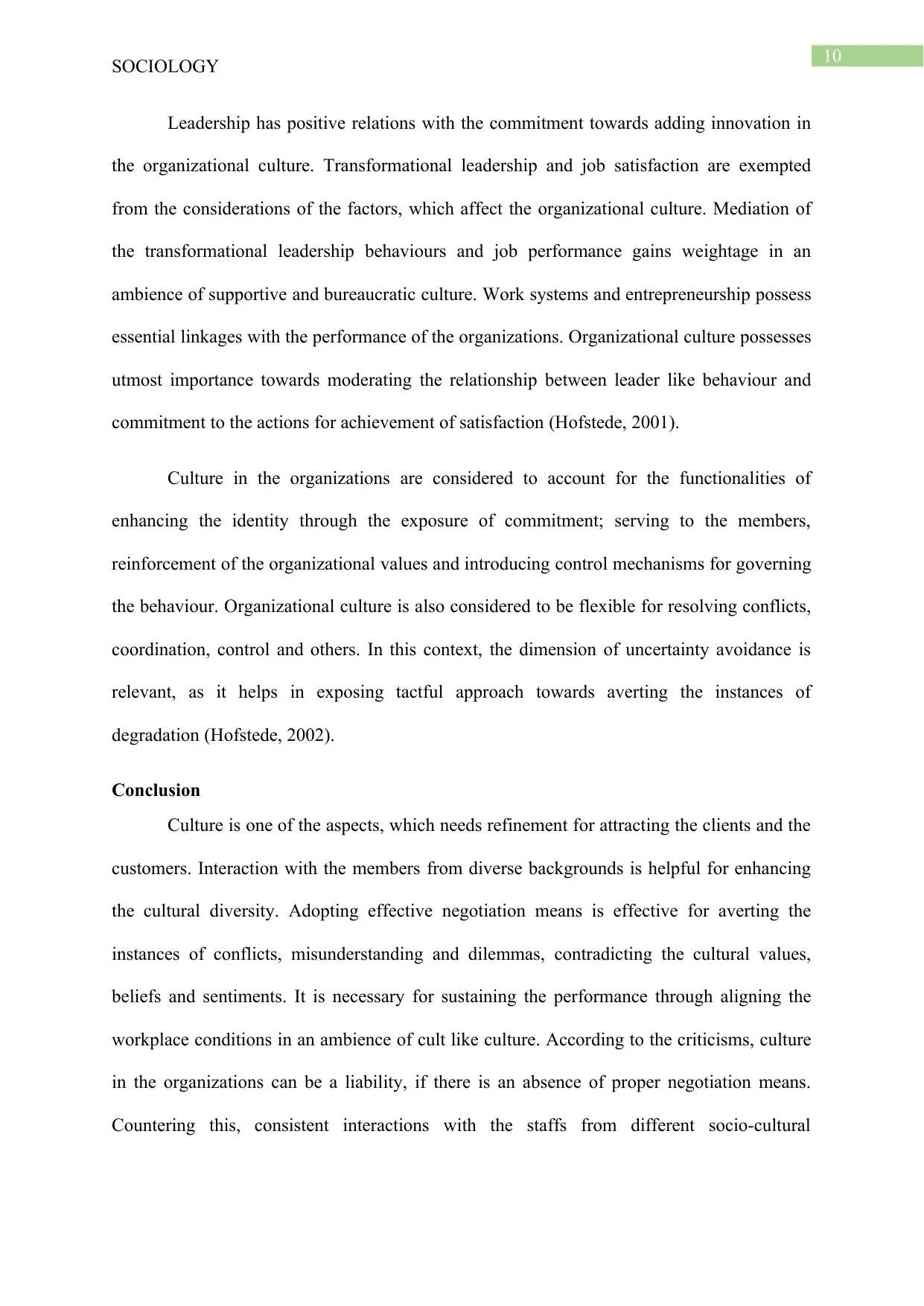
10
SOCIOLOGY
Leadership has positive relations with the commitment towards adding innovation in
the organizational culture. Transformational leadership and job satisfaction are exempted
from the considerations of the factors, which affect the organizational culture. Mediation of
the transformational leadership behaviours and job performance gains weightage in an
ambience of supportive and bureaucratic culture. Work systems and entrepreneurship possess
essential linkages with the performance of the organizations. Organizational culture possesses
utmost importance towards moderating the relationship between leader like behaviour and
commitment to the actions for achievement of satisfaction (Hofstede, 2001).
Culture in the organizations are considered to account for the functionalities of
enhancing the identity through the exposure of commitment; serving to the members,
reinforcement of the organizational values and introducing control mechanisms for governing
the behaviour. Organizational culture is also considered to be flexible for resolving conflicts,
coordination, control and others. In this context, the dimension of uncertainty avoidance is
relevant, as it helps in exposing tactful approach towards averting the instances of
degradation (Hofstede, 2002).
Conclusion
Culture is one of the aspects, which needs refinement for attracting the clients and the
customers. Interaction with the members from diverse backgrounds is helpful for enhancing
the cultural diversity. Adopting effective negotiation means is effective for averting the
instances of conflicts, misunderstanding and dilemmas, contradicting the cultural values,
beliefs and sentiments. It is necessary for sustaining the performance through aligning the
workplace conditions in an ambience of cult like culture. According to the criticisms, culture
in the organizations can be a liability, if there is an absence of proper negotiation means.
Countering this, consistent interactions with the staffs from different socio-cultural
SOCIOLOGY
Leadership has positive relations with the commitment towards adding innovation in
the organizational culture. Transformational leadership and job satisfaction are exempted
from the considerations of the factors, which affect the organizational culture. Mediation of
the transformational leadership behaviours and job performance gains weightage in an
ambience of supportive and bureaucratic culture. Work systems and entrepreneurship possess
essential linkages with the performance of the organizations. Organizational culture possesses
utmost importance towards moderating the relationship between leader like behaviour and
commitment to the actions for achievement of satisfaction (Hofstede, 2001).
Culture in the organizations are considered to account for the functionalities of
enhancing the identity through the exposure of commitment; serving to the members,
reinforcement of the organizational values and introducing control mechanisms for governing
the behaviour. Organizational culture is also considered to be flexible for resolving conflicts,
coordination, control and others. In this context, the dimension of uncertainty avoidance is
relevant, as it helps in exposing tactful approach towards averting the instances of
degradation (Hofstede, 2002).
Conclusion
Culture is one of the aspects, which needs refinement for attracting the clients and the
customers. Interaction with the members from diverse backgrounds is helpful for enhancing
the cultural diversity. Adopting effective negotiation means is effective for averting the
instances of conflicts, misunderstanding and dilemmas, contradicting the cultural values,
beliefs and sentiments. It is necessary for sustaining the performance through aligning the
workplace conditions in an ambience of cult like culture. According to the criticisms, culture
in the organizations can be a liability, if there is an absence of proper negotiation means.
Countering this, consistent interactions with the staffs from different socio-cultural
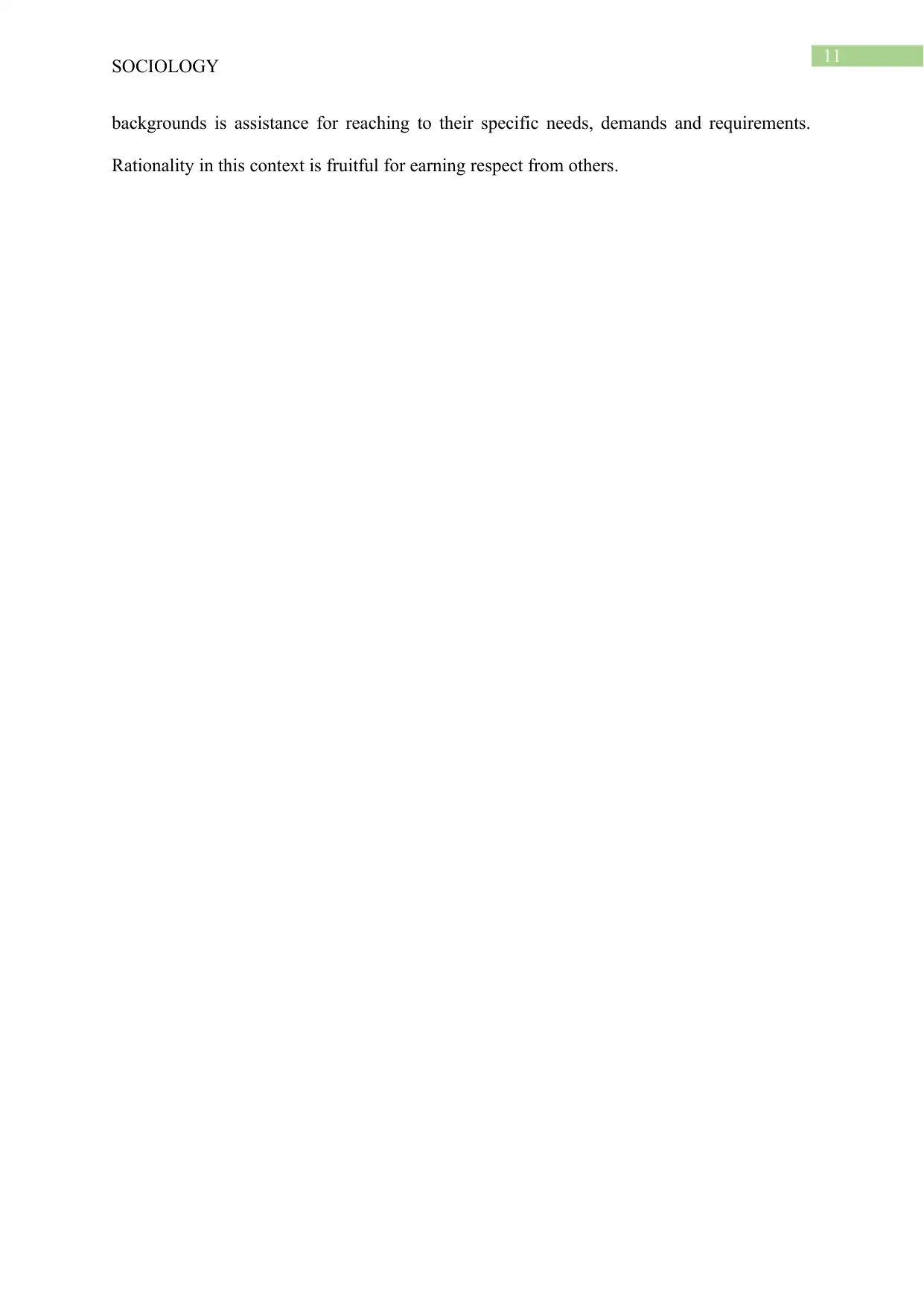
11
SOCIOLOGY
backgrounds is assistance for reaching to their specific needs, demands and requirements.
Rationality in this context is fruitful for earning respect from others.
SOCIOLOGY
backgrounds is assistance for reaching to their specific needs, demands and requirements.
Rationality in this context is fruitful for earning respect from others.
⊘ This is a preview!⊘
Do you want full access?
Subscribe today to unlock all pages.

Trusted by 1+ million students worldwide
1 out of 14
Related Documents
Your All-in-One AI-Powered Toolkit for Academic Success.
+13062052269
info@desklib.com
Available 24*7 on WhatsApp / Email
![[object Object]](/_next/static/media/star-bottom.7253800d.svg)
Unlock your academic potential
Copyright © 2020–2025 A2Z Services. All Rights Reserved. Developed and managed by ZUCOL.




